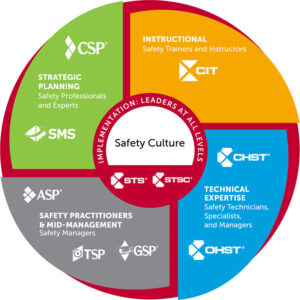 In the peer-reviewed “Leadership’s Effect on Safety Culture” published in Professional Safety’s November 2018 issue, Lundell and Marcham find safety culture and leadership linked as critical components of organizational health. The authors go on to underscore the advantages of a certified and professional safety perspective in business and operational planning.
In the peer-reviewed “Leadership’s Effect on Safety Culture” published in Professional Safety’s November 2018 issue, Lundell and Marcham find safety culture and leadership linked as critical components of organizational health. The authors go on to underscore the advantages of a certified and professional safety perspective in business and operational planning.
The Board of Certified Safety Professionals began as a professional development project formed by an executive committee of the American Society of Safety Engineers (ASSE—now ASSP) in 1963. This beginning would shape the future of safety as a profession, beginning with the Certified Safety Professional (CSP) certification, which was first offered in 1970. Over the next 49 years, BCSP would go on to introduce seven additional certifications and two designations.
In addition to the CSP, BCSP now offers the Associate Safety Professional (ASP), Safety Management Specialist (SMS), Occupational Hygiene and Safety Technician (OHST), Construction Health and Safety Technician (CHST), Safety Trained Supervisor (STS), Safety Trained Supervisor Construction (STSC), and the Certified Instructional Trainer (CIT) certifications.
While the CSP is considered by professional leaders to be the “gold standard” of safety certification, each BCSP certification plays an important role in creating a robust, all-encompassing safety culture. Each was specifically designed to serve an organizational niche, with varying degrees of focus — some focused on a narrower part of safety, while others encompass additional elements of safety.
For example, the CSP and SMS are geared more towards strategic planning, with safety experts and professionals focusing on the company-wide prevention of harm and loss. A CSP may institute safety management systems, emergency response and preparedness, occupational health and ergonomics, etc. Likewise, an SMS typically supervises employees and defines an organization’s safety management systems, risk management, incident investigation, etc. A CSP is more education-based, requiring a bachelor’s degree, while an SMS requires 10 years of experience.
The ASP is a mid-level certification that fulfills the credential requirement leading to the CSP. An ASP may also supervise employees and typically holds positions at the technical level or program management level. An ASP can serve as a key member of projects or design teams and may be asked to coordinate safety activities, conduct safety analyses, etc. A bachelor’s degree in any field or an associate’s in SH&E are prerequisites for the ASP. The Transitional Safety Practitioner (TSP) and Graduate Safety Practitioner (GSP) designations also fall in this category and serve as a path to obtain the CSP.
The CHST and OHST both fall under the technician level, meeting the needs of professionals with narrower foci on safety and leadership with expertise in the certifications’ specific areas of concentration. The OHST, as its name implies, focuses more on occupational hygiene; the CHST focuses on the building construction or general contracting sector. Experience requirements for both are three years and there are no academic nor training requirements.
The STS and STSC are supervisory certifications focused on employees at all levels of organizations, from the CEO to the front-line supervisor, who may not have safety as a primary duty but who, by possessing the safety baseline knowledge afforded them by obtaining these certifications, are able to ensure safer and healthier work sites.
And finally, the CIT is designed for safety trainers and instructors. A CIT usually holds positions at the manager, director, technician, or supervisory level and designs a corporation’s SH&E training. They may also hold other duties outside safety.
A profound safety culture, one with certified and professional safety leadership, requires competency across the organization and requires leaders to value and model safety at all levels. By utilizing the varying focuses of the ensemble of BCSP certifications, an organization ensures their safety culture encompasses all aspects of safety, health, and environment.
